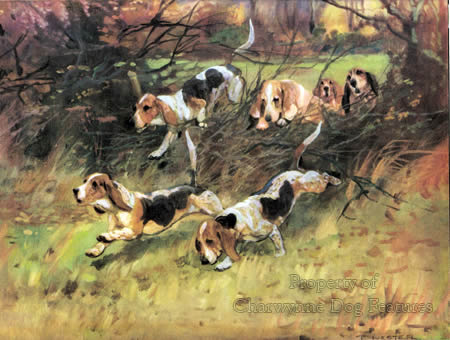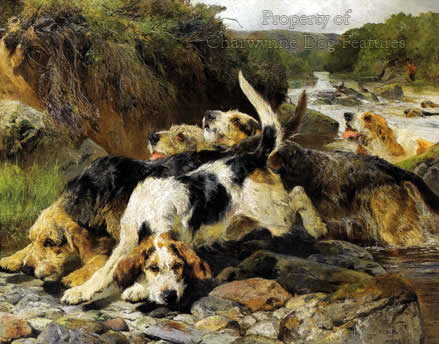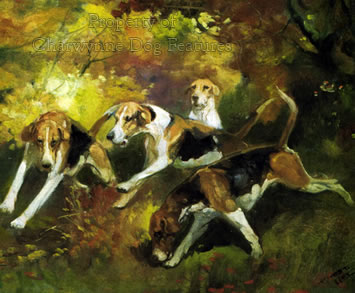522 LOOKING AT HOUNDS
LOOKING AT HOUNDS – Making A Judgement
by David Hancock
.jpg) "A perfect foxhound is like a great picture - its wondrous beauty grows upon you by degrees, and the more you look the more you admire..."
"A perfect foxhound is like a great picture - its wondrous beauty grows upon you by degrees, and the more you look the more you admire..."
from Hunting by Otho Paget, 1900.
“In 1911, there were nearly four hundred packs in Great Britain and Ireland, not counting foot harriers, beagles, and otter hounds. The first hound show was held at Redcar, in 1859, and since then exhibitions have, little by little, augmented interest in the show points of hounds, regardless of their working ability, until the show type English foxhound has become marvelously uniform in a certain standard of conformation most pleasing to the eye that is accustomed to such a standard. However, whilst this ‘perfection to please the eye’ has gone on, certain qualities have been neglected, notably, nose and cry. Its cry is now deficient, and its nose is regarded by many as the most inefficient in any breed of scenting hound.”
From Hounds & Hunting through the Ages by Joseph B Thomas, Garden City, 1937.
Looking at hounds will always be a source of joy to me, the condition of the hounds alone giving so much pleasure. A hound show, especially one as well-conducted as the annual Honiton or Dunster Lawns events, is for me a celebration of all the pleasures provided by these canine athletes. The sheer style and restrained pageantry of judging at a hound show adds to this celebration, a welcome contrast to the urban atmosphere of most KC-licensed dog shows. Thirty years ago I was standing at the ringside of a KC championship dog show when I overheard the following conversation; younger man: "Why does the judge need to put his hands on the dogs?" Older man: "Because you don't become an architect by staring at walls!" I was reminded of this snatch of conversation when attending the 1999 hound show at Honiton and one a decade later on Dunster Lawns. The judges were immaculately attired; the hounds beautifully presented; their handlers colourful and impressive; the sun shone, all was right with the world; but was it?
Hounds on Parade
The splendid Honiton show, with its dazzling array of hounds: Beagles, Harriers, Foxhounds, Staghounds and Minkhounds, is always rewarding to visit but this time I felt disappointed. First of all, only the Minkhound judge examined the mouths of exhibits; does dentition, 'bite' and jaw construction not matter in animals designed to hunt? Secondly, the hounds were never touched by the judges, to verify muscle tone, bone and the construction of key joints. Thirdly, the hounds could only be animated in the ring by being urged to chase a constant shower of small biscuits. To me this totally degrades canine athletes bred to near perfection and shown in superb condition. Here were magnificent hounds from distinguished packs being treated like village curs. Could they really not show off their movement without such demeaning public bribery?
Writing on this in Hounds magazine in December, 1994, ‘Mariner’ contributed to a debate on Beagle judging at a hound show by giving the view: “This summer, as I walked out my own hounds…I pondered more and more on…how we judge our beagle hounds…In the show ring, we ‘stand’ our hounds – and ‘move them’. This entails getting them, by judicious dispensing of biscuit, to gallop continually from one end of the ring to the other. This is an important ‘exercise’, because it helps to judge ‘stride’ and ‘balance’. But at the gallop it is very difficult to see how straight a hound moves…In the horse world or at championship dog shows, no judge would want to put up any entry that he had not seen fully at the slow paces as well as the fast…Finally, why do hound judges never look at a hound’s mouth?” I share his concerns; it is not just the knowledge the judges possess but the technique they use to ensure their knowledge is precisely applied.
Hands-on Examination
After several months of watching all too many overweight under-muscled dogs parading, sometimes waddling, around the rings at KC conformation shows, it was a delight at Honiton to see the rippling muscles, effortless movement and sheer athleticism of these well-bred functional animals. These were surely the best of the best, this was their day, rosettes awaited. But then came a further disappointment as I studied one or two hounds quite closely and was allowed to run my hands over them. Behind the muscular suppleness, graceful outlines and noble bearing, were some of the long-acknowledged anatomical scenthound faults: Fleshy feet, toeing-in, over-boned pasterns and ramrod-straight forelegs when viewed from the side. This was disappointing, because although none of these flaws were present to an alarming degree, these were the very best hounds of their packs, carefully selected representatives.
I suppose it could be argued that if hounds can hunt successfully over a long day in difficult country, then that is the best possible test for them. But a hound show is a competition to find the best-made hounds, often with breeding programmes in mind. If judges are not going to bother to look at mouths, examine the feet or feel the shoulders and loins of the exhibits, faults can so easily be overlooked. If hounds can be entered, with the intention of their not only representing their pack but also striving for the honours, whilst carrying noticeable physical flaws, then, behind all the admirable glamour of such a prestigeous show, is there real credibility?
That may sound over-critical and as though arguing a case for fault-judging, with the latter of course something to be discouraged. But I don't want our precious hounds to be judged on the bloom of their coats, their showiness when 'stacked' or their flashy markings but on their soundness. In any sporting dog, and especially in a hound used to hunt live quarry, feet and legs, shoulders and loins, the position of the elbow and jaw construction are vitally important. If the hounds taken to a houndshow to be judged on the flags by the experts of the day have worrying faults, what are the hounds like which are left in kennels?
The Shorthorn Era
I have written earlier on how, in the second half of the 19th century, the Foxhound fraternity lost its collective head and actually favoured massive leg bone, over-knuckled feet, bunched toes and woefully pin-toed fronts. The redoubtable 'Ikey' Bell and his followers fought hard against such folly and the penalty to a hound of being over-timbered or unsound afoot was eventually conceded. Quite why any lover of hounds would want them to resemble carthorses has never been satisfactorily explained. What is frightening about what Daphne Moore has called the 'shorthorn' era is that so many highly-experienced MFHs and huntsmen went along with the foolishness of the day. Consensual foolishness is still foolishness!
That is why it is worth the risk of the accusation of being hypercritical and of suggesting judging on faults. At a time when there are serious external threats to our native hounds we can do without internal ones. When I judge working terriers, I assess their physical soundness, the ability of their anatomy to allow them to perform in the field. When I judge working tests for gundogs, I assess them on their working skills as displayed at the time. When I judge, say, American Bulldogs, I look for the construction of a 'catch-dog' or 'holding dog', as once needed by primitive hunters to 'grip' their quarry after the scenthounds had hunted and 'bayed' it. Sporting dogs, whatever their cosmetic appeal, have to function.
Breeding Hounds for Show
Major Maurice Barclay, in Hounds and Dogs (Lonsdale Library), 1932, makes a point for me when he states: "...it is with the working capabilities of a foxhound in view that judges at Hound Shows look for certain points. These points are not just for show purposes to please the eye and fashion only, as so many unthinking sportsmen seem to imagine." I would like to see hound show judges, and 'not just for show purposes', examine mouths. Jardine, in his well-known Hounds of the World, 1937, wrote that: "In judging hounds, little or no attention is paid, as a rule, to their heads..." Whatever the precedent, it cannot be good sense, heads, especially jaws, really do matter.
Jardine also wrote: "...that exaggerated straightness which causes a hound to turn his toes right in, is a mistake." At Honiton there were several hounds with pin-toed fronts. There were several hounds there that were far too straight in the foreleg when viewed from the side. In his Foxes, Foxhounds and Foxhunting of sixty years ago, Richard Clapham noted that: "It will be easily understood that the shorter and straighter the pastern, the more jar will there be, and the quicker will it be carried to the knee, and so upwards. Also, the heavier the bone, the greater the concussion..." There were several hounds at this show that were too straight in the pastern in profile and over-boned at the knee.
In her informative Foxhounds of 1981, Daphne Moore wrote: "Good clean flat bone, similar to that of a greyhound, is the type required, not the rounded vulgar variety..." Why would anyone want a hound with thick ankles? When the esteemed Beckford wrote in his Thoughts on Hunting of 1797 on the Foxhound "Let his legs be straight as arrows...", he meant when seen from the front, not the side. Most of the hounds in the ring at Honiton in 1999 were excellent. Some however displayed too much weight on the forehand, standing on the outside of each foot, pin-toed fronts, out at elbow, knuckling over at the knee and bunched-up toes. Some may have had defective mouths but this would have gone undiscovered. But feet and knees are even more important.
Knees and Feet
The arguments over whether a round compact foot is preferable to the oval hare-foot in scenthounds have gone on for two centuries. In his contribution to The Lonsdale Library’s Deer, Hare & Otter Hunting of 1929, the Earl of Stradbroke, Master of the Henham Harriers, had this to say about feet and pasterns: “I have found that the hounds that last the longest, and go out on the greatest number of days in the season, are the lighter built hounds, often, too, those with what we all try to breed out, ‘hare-feet’!…I cannot help thinking that in advocating so strongly a short joint we go too far, and there should be a little more length, than is generally considered to be the perfection aimed at. Greater length gives the necessary elasticity to save a jar to the shoulder, when landing from a jump.” If, however, you look at the breed standards of the hound breeds, hunting by scent, recognized by the KC you find considerable variation between them. A Beagle’s feet must not be hare-footed; the Otterhound’s and the Foxhound’s feet have to be round; the Grand Bleu de Gascogne’s feet have to be long and oval; the Norwegian Elkhound’s feet have to be slightly oval; the Finnish Spitz’s feet need to be round; the Basset Bleu de Gascogne’s feet should be oval. No wonder the breeders of these breeds and those who judge them in the ring get confused by conflicting instructions.
Being Let Down
Stradbroke’s point about saving ‘a jar to the shoulder’ is a fair one; ramrod straight front legs, as seen from the side, lack spring and force-absorption; too short a pastern in the front legs restricts that essential springiness. The breed standards also insist that such breeds are well let-down at hock i.e. having their hocks close to the ground. This is an often misunderstood term; in both racehorses and sporting dogs, the seeking of long cannon bones led to the use of this expression. It was never intended to promote short rear pasterns but the promotion of long muscles in what in humans is the calf, leading to a low-placed hock or heel. In a different sense sporting dogs are being ‘let down’ by such advice in both cases set out above; elasticity is essential in the hound’s front legs and ample extension is vital in the hind-limbs. Over-compact feet, rounded and too tight, are in fact a handicap when the hound is striving to gain from ground pressure at pace, as users of the Fell Hound have long accepted. The KC’s breed standards are ill-advised and judges are slavishly obeying them whereas they should be challenging them. 
Show Ring Follies
I have seen some quite magnificent scenthounds on parade in show rings, from Honiton to Hungary; I have also seen, both in kennel club conformation shows around Europe and in shows for hounds from the packs in England, some disappointingly mediocre ones. At Crufts you expect to see ‘the Best of the Very Best’, as the KC promises. But I do see Beagles there with too much flesh, far heavier bone than in say a working pack like the Dummer and with front feet that toe-in. The Basset Hounds there are to me woeful exaggerations of hounds originally bred for the hunting field. The Bassets Fauve de Bretagne, however, usually impress. The Otterhounds seem to be heading away from the waterproof coats of their ancestors and the Bloodhounds are too loose-lipped, over-dewlapped and too throaty. I have seen a couple of sound Foxhounds, but their breeding was closer to the packs. I like the look of the Bavarian Mountain Hounds and the Vendeen Bassets. The Hamiltonstovares are a handsome breed but how good it would be to see a parade of Harriers, Fell Hounds, Trailhounds, Welsh Hounds and Staghounds from the packs. The total separation of the three sports, showing, trailing and hunting, does not benefit the hounds. The show breeders could learn a great deal from the hunting field and mutual understanding in times when using hounds are so curtailed has to be for the better. It would be good to see the KC encourage the packs to attend and have the very best long-term interests of the hound breeds at the front of their minds. Far too many show judges just look at the entry; they should be visualising the entry, imagining them hunting, crossing obstacles, enduring the extremes of climate, maintaining pace for mile after mile and able to fulfill their prescribed function. How can you strive to perpetuate a breed if you ignore its whole purpose?